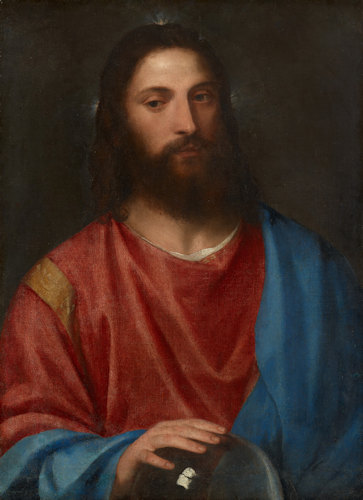
Nope, not the da Vinci one, but a version attributed to Titian. A small display area at the Kunsthistorisches Museum (KHM) reveals the results of research into the craftsmanship and history of Christ with an Orb.
- Number 25 in the Point of View series
- Runs Feb 25 – Oct 16, 2022
- Text in English and German
- Built into the permanent paintings exhibition
- Suited to those wanting a little more depth to what they see
- See also:
- Current art exhibitions in Vienna
Titian’s Christ with an Orb
(Tiziano Vecellio, called Titian (c. 1488-1576); Christ with an Orb: c. 1520/30: inv. GG 85 © KHM-Museumsverband)
One of the pleasures of the Kunsthistorisches Museum is when they scratch beneath the surface of an artwork in their possession (not literally, of course, since that might raise a few eyebrows). They should do it more often.
An example is the 25th edition of the museum’s Point of View exhibition series. This one features Christ with an Orb: attributed to the 16th-century Venetian master, Titian, and a variation on the Salvator Mundi motif.
Innocent visitors like myself normally wander past such objects, nod, and move on. But a long-term Titian research project funded by the Austrian Fund for Scientific Research adds a new dimension to the work.
The State Hermitage Museum in St. Petersburg, for example, has Titian’s 1570(ish) Christ Blessing following the typical Salvator Mundi iconography: the subject’s hand raised in blessing and an orb topped with a cross.
The KHM’s (probable) Titian has Christ’s hand simply resting on an orb without a cross. His face seems more pensive than in the Russian pendant.
So what does research have to say about the painting and the change in approach? That’s what the small exhibition area is all about.
We discover, for example, how a patron’s Kaballah-influenced understanding of Christianity may have affected the representation of Christ. And we see two x-ray images and an infrared reflectogram that throw light (bad dum tish!) on the history of the work.
The images reveal, for example, the different dimensions of the original outline, retouched areas, and the existence of a Madonna and Child painting underneath.
Viewing the x-rays in particular feels a little like one of those magic 3d pictures: the underlying work seems to slowly reveal itself with the help of interpretive labels.
As well as producing those little insights that add depth to the presentation and enjoyment of museum art, the research has important documentary value.
The results reinforce the attribution of the painting to Titian, suggest the date of creation may have been earlier than supposed (the 1520s rather than 1530), and shed more light on the artist’s techniques and approach.
Dates and tickets
Enjoy a look beneath Titian’s painting from February 25th to October 16th, 2022.
The small display area with just a couple of info boards occupies a cabinet room just off gallery (Saal) XI up among the museum’s paintings collection. That Saal has works by Albrecht Dürer, Hans Holbein the Younger, and others.
Incidentally, Saal X has the renowned Bruegel collection. And Saal IV has more Titians for you (the Kunsthistorisches Museum’s Titian collection is second only to Spain’s Museo Nacional del Prado’s in size).
Rooms on the same floor host the main spring/summer exhibition on Renaissance armour: Iron Men.
For more examples of paintings from that era, also consider a visit to the Gemäldegalerie of the Academy of Fine Arts Vienna.
How to get to the exhibition
Once you find the Kunsthistorisches Museum, go up to the floor with the paintings galleries.
Address: Maria-Theresien-Platz, 1010 Vienna
